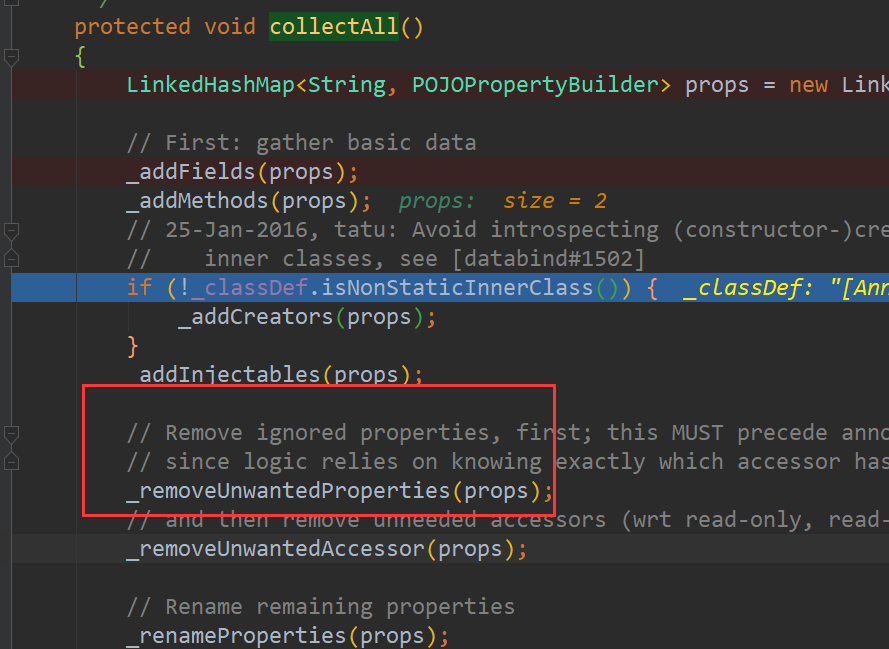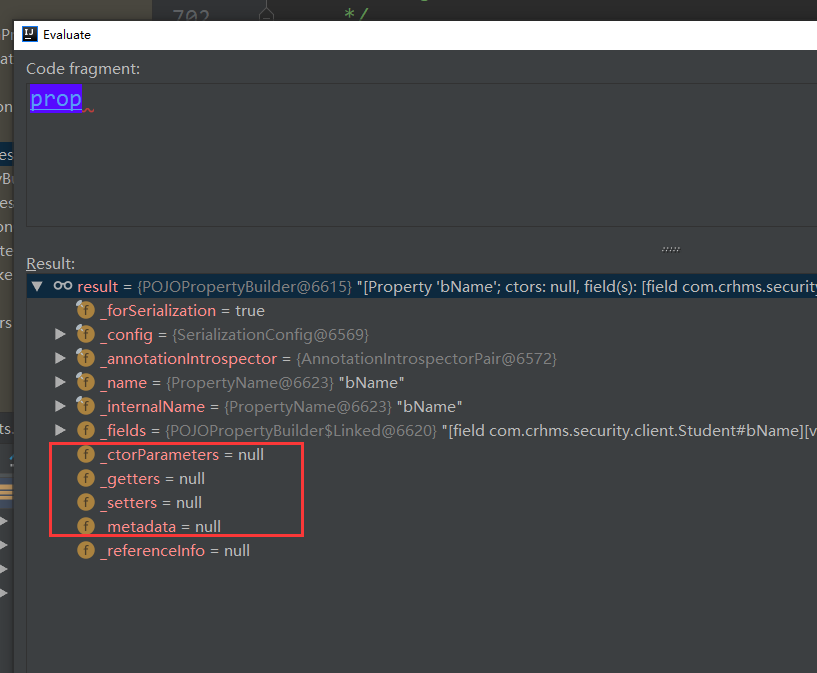jackson json序列化实现首字母大写,第二个字母需小写
有这样一个类:
@Setter
@Getter
@JsonNaming(value = PropertyNamingStrategy.UpperCamelCaseStrategy.class)
public class Student {
private String bName;
}
序列化后,希望首字母大写,如下面的测试代码:
@Test
public void contextLoads() throws IOException {
Student test = new Student();
test.setBName("234234");
String s = objectMapper.writeValueAsString(test);
Assert.assertEquals("{\"BName\":\"234234\"}", s);
}
可实际运行后,结果与希望不一样:
org.junit.ComparisonFailure:
Expected :{"BName":"234234"}
Actual :{"Bname":"234234"}
jackson在序列化时把第二个大写字母n转成了小写,这是为什么呢?
以下是跟踪源码的过程:
直接找到:com.fasterxml.jackson.databind.introspect.POJOPropertiesCollector#collectAll这个方法:

执行完_addFields(props)方法后:

执行完_addMethods(props)方法后:

一个是bName,一个是bname;
第一个bName取的是字段的名称,
第二个bname是取的它的set方法:
public static String okNameForIsGetter(AnnotatedMethod am, String name,
boolean stdNaming)
{
if (name.startsWith("is")) { // plus, must return a boolean
Class<?> rt = am.getRawType();
if (rt == Boolean.class || rt == Boolean.TYPE) {
return stdNaming
? stdManglePropertyName(name, 2)
: legacyManglePropertyName(name, 2);
}
}
return null;
}
根据stdNaming来决定这个name是以什么标准输出,默认的是false;
stdManglePropertyName 就是原始输出。
legacyManglePropertyName 就是规范输出。
下面的代码就是规范输出:
protected static String legacyManglePropertyName(final String basename, final int offset)
{
final int end = basename.length();
if (end == offset) { // empty name, nope
return null;
}
// next check: is the first character upper case? If not, return as is
char c = basename.charAt(offset);
char d = Character.toLowerCase(c);
if (c == d) {
return basename.substring(offset);
}
// otherwise, lower case initial chars. Common case first, just one char
StringBuilder sb = new StringBuilder(end - offset);
sb.append(d);
int i = offset+1;
for (; i < end; ++i) {
c = basename.charAt(i);
d = Character.toLowerCase(c);
if (c == d) {
sb.append(basename, i, end);
break;
}
sb.append(d);
}
return sb.toString();
}
主要逻辑在for循环中,去除set后,第一个字母小写,
第二字母小写后,与第二个字母比较,如果都是小写,则直接接上,返回,
如果第二字母大写,就如我们的这种情况,就以小写的情况,接上,再去找下一个字母,直到找到小写字母为止。
意思就是为了满足驼峰命名规则,要规范输出。
如果我们的字段命名正如它的规范的话,props是只有一条记录的,因为:名称相同,就不插入了,由于咱们的名称不同,所以就有两条记录。
protected POJOPropertyBuilder _property(Map<String, POJOPropertyBuilder> props,
String implName)
{
POJOPropertyBuilder prop = props.get(implName);
if (prop == null) {
prop = new POJOPropertyBuilder(_config, _annotationIntrospector, _forSerialization,
PropertyName.construct(implName));
props.put(implName, prop);
}
return prop;
}
可是我们输出中只有一条,没有bName这条,

其实在是这里把第一条删除了。因为:

这些属性为空,导致这个字段不可见:
protected void _removeUnwantedProperties(Map<String, POJOPropertyBuilder> props)
{
Iterator<POJOPropertyBuilder> it = props.values().iterator();
while (it.hasNext()) {
POJOPropertyBuilder prop = it.next();
// First: if nothing visible, just remove altogether
if (!prop.anyVisible()) {
it.remove();
continue;
}
// Otherwise, check ignorals
if (prop.anyIgnorals()) {
// first: if one or more ignorals, and no explicit markers, remove the whole thing
if (!prop.isExplicitlyIncluded()) {
it.remove();
_collectIgnorals(prop.getName());
continue;
}
// otherwise just remove ones marked to be ignored
prop.removeIgnored();
if (!prop.couldDeserialize()) {
_collectIgnorals(prop.getName());
}
}
}
}
只剩第二记录bname,再首字母大写,所以就是Bname了。
解决方案:
第一个就是JsonProperty
@Setter
@Getter
@JsonNaming(value = PropertyNamingStrategy.UpperCamelCaseStrategy.class)
public class Student {
@JsonProperty("BName")
private String bName;
}
测试结果如下:
org.junit.ComparisonFailure:
Expected :{"BName":"234234"}
Actual :{"Bname":"234234","BName":"234234"}
虽然生成了BName,但是Bname仍在(加了JsonProperty就visable了)。
第二个就是配置objectMapper的MapperFeature.USE_STD_BEAN_NAMIN如上文提到了,非规范化输出。
如下代码:
@Test
public void contextLoads() throws IOException {
Student test = new Student();
test.setBName("234234");
objectMapper.configure(MapperFeature.USE_STD_BEAN_NAMING, true);
String s = objectMapper.writeValueAsString(test);
Assert.assertEquals("{\"BName\":\"234234\"}", s);
}
第三个方案:重写PropertyNamingStrategy:
@Test
public void contextLoads() throws IOException {
Student test = new Student();
test.setBName("234234");
//objectMapper.configure(MapperFeature.USE_STD_BEAN_NAMING, true);
objectMapper.setPropertyNamingStrategy(new PropertyNamingStrategy() {
private static final long serialVersionUID = 1L;
// 反序列化时调用
@Override
public String nameForSetterMethod(MapperConfig<?> config,
AnnotatedMethod method, String defaultName) {
return method.getName().substring(3);
}
// 序列化时调用
@Override
public String nameForGetterMethod(MapperConfig<?> config,
AnnotatedMethod method, String defaultName) {
return method.getName().substring(3);
}
});
String s = objectMapper.writeValueAsString(test);
Assert.assertEquals("{\"BName\":\"2342344\"}", s);
}
修改objectMapper的配置,要注意对其他功能的影响。
以上为个人经验,希望能给大家一个参考,也希望大家多多支持我们。

